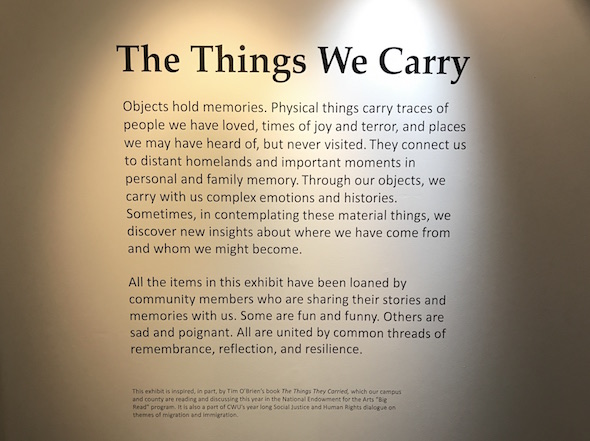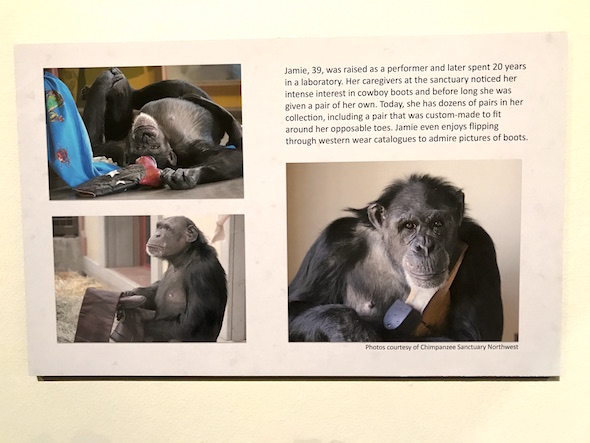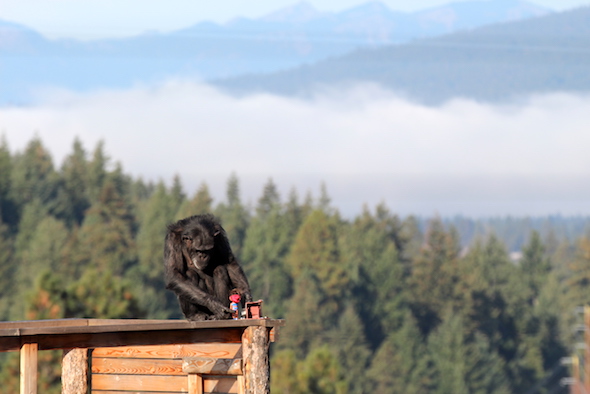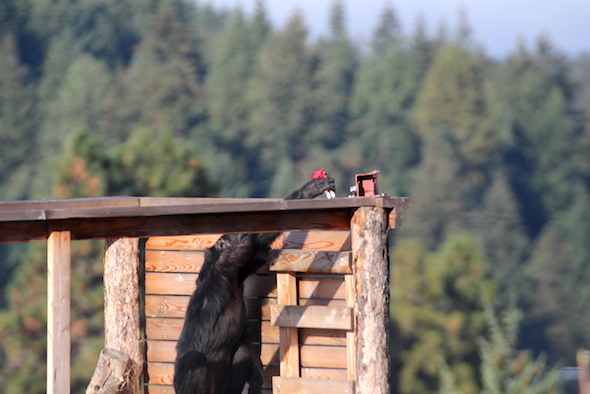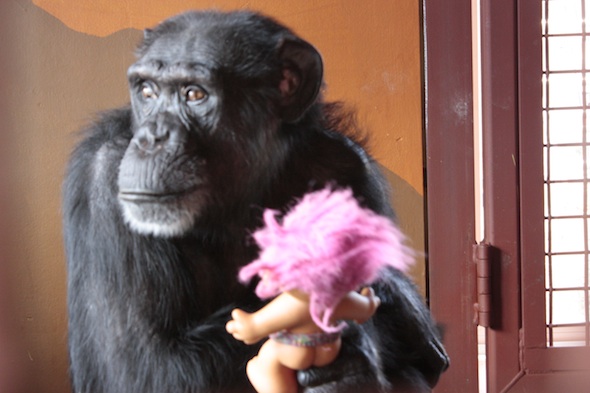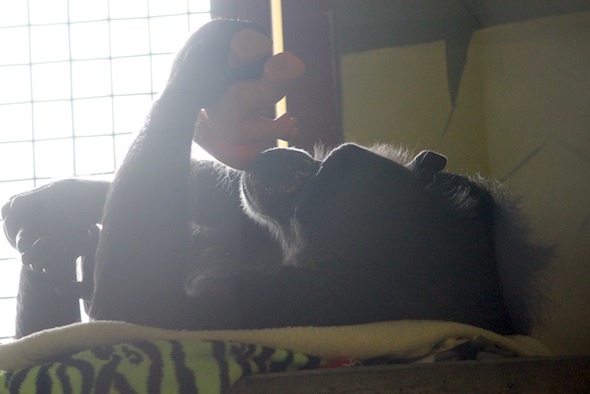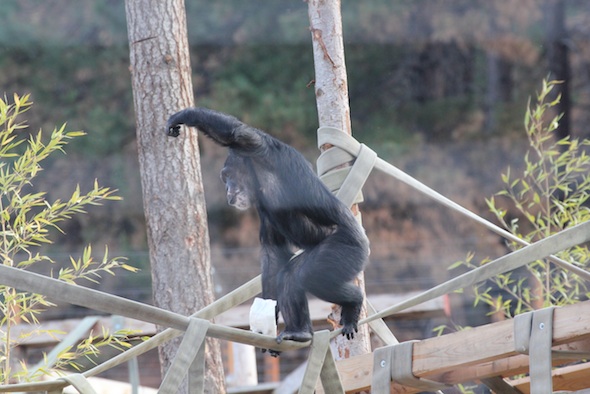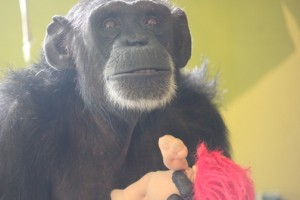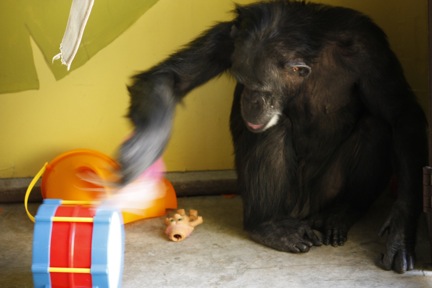A few months ago, Chimpanzee Sanctuary Northwest was invited to contribute to an exhibit in the Museum of Culture and Environment at Central Washington University. The exhibit, entitled “The Things We Carry,” would feature objects of significance to the members of our local community.
Our community, of course, includes seven chimpanzees, and you’d be hard pressed to find objects of greater significance to their owners than the boots and dolls carried by Jamie and Foxie.
During the opening reception for the exhibit, Dr. Jessica Mayhew, who is both a professor in the Primate Behavior and Ecology program at CWU and a CSNW volunteer, provided some very moving remarks on the installation:
When you have the opportunity to go in and experience the exhibit, you’ll see some objects that undoubtedly look familiar to you. A pillowcase, a toddler’s dress, empty bags of potato chips. Also encased are some cowboy boots and dolls. Cowboy boots in this region are common, and many of us can surely remember the various iterations of Troll dolls beginning in the 1960s.
But what’s special about these boots and these dolls, is that the objects do not belong to humans, they belong to two chimpanzees from Chimpanzee Sanctuary Northwest: Jamie and Foxie. Jamie and Foxie are only two of seven chimpanzees residing at CSNW, and they are not the only chimpanzees that carry objects, but their object carrying has become iconic, picked up in popular news stories across the US and globally.
As a primatologist, I have watched my fair share of object manipulation, tool creation, and object play in macaques, in capuchins, in the large-bodied apes. Jane Goodall first described tool use in chimpanzees in 1960, when she observed David Greybeard termite fish with a piece of grass. We’ve been grappling with the implications of those observations ever since.
Objects occupy a wide functional range in the lives of primates. Some are used in the acquisition and processing of food – capuchin monkeys carry large, hard hammer stones up from nearby riverbeds to their nut cracking sites; chimpanzees have been observed to carry sticks, stems, and sturdy grasses from one location in their home range to termite and ant nests, where they know they will not find suitable fishing materials. Objects do not always have to be inanimate: mother primates regularly carry their infants, most often on their backs, but sometimes on the chest, which can make walking a bit of a challenge. Still other objects are used in ways that we have only begun to observe and decipher: stone handling in multiple macaque species, log and rock cradling in chimpanzees.
But there is something different when the object is one that’s familiar to us; one that may have played a large role in our childhood, like dolls or action figures, or is an object that is perhaps a part of the larger cultural fabric of a place, like cowboy boots. When familiar objects are put into hands that are a little less familiar, it makes the divide between human and non-human a little bit narrower.
There are 7 chimpanzees at CSNW, all of them very much individuals, all of them vibrant and compelling; they were known as “The Buckshire Seven”, because they were housed at the Buckshire Corporation in a windowless basement, and spent the majority of their lives leased out for various biomedical studies. Jamie was born in captivity around 1977, and she spent the first nine years of her life in the entertainment industry before entering into the biomedical realm. Foxie, on the other hand, was born into the biomedical industry in 1976: she was used in vaccine trials, she was used as a breeder. Each time she gave birth, her infant was carried away by humans.
This group became “The Cle Elum Seven” when they moved to sanctuary in 2008. Jamie has spent the last nine years of her life, taking chimpanzee patrols around the property with her human friends, who are always in boots. Foxie has no shortage of dolls to carry with her, and no risk of them not being there each day.The exhibit description tells us that, “Objects hold memories. Physical things carry traces of people we have loved, times of joy and terror, and places we may have heard of, but never visited. They connect us to distant homelands and important moments in personal and family memory. Through our objects, we carry with us complex emotions and histories. Sometimes, in contemplating these material things, we discover new insights about where we have come from and whom we might become.”
Maybe Jamie’s very specific love of cowboy boots comes from her early days reared with humans. Maybe Foxie’s love of dolls comes from never fully experiencing motherhood. Maybe, I’ll leave that for them to know, ultimately. But I will say that these objects serve as reminders for us, as onlookers, for where these chimpanzees have been and for what humans have done to them. They are powerful expressions of both great sadness and great silliness. But they also serve as symbols of hope, that circumstances can change, that life can be better and full of kindness and compassion.
The exhibit title, “The Things We Carry” seems all the more fitting now with the inclusion of these artifacts from our closest relatives. This is a community-curated exhibition. Not just this local community of humans with stories to tell, and memories to conjure, but the deep roots shared by humans and our closest kin. Indeed, we are all carrying physical, emotional, and metaphorical things.
